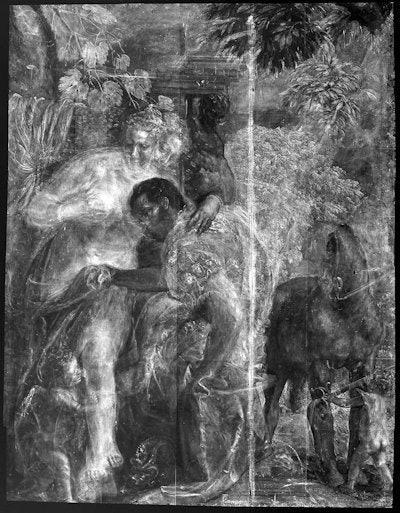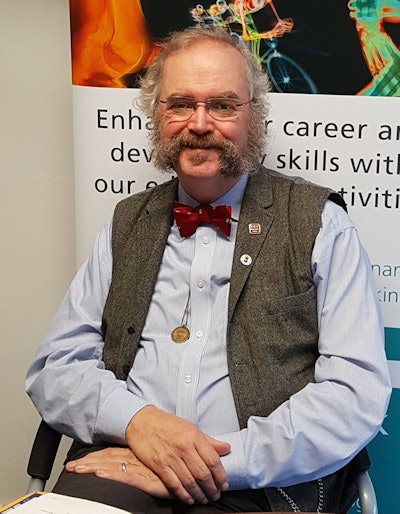
There has recently been considerable interest in a previously unknown portrait of Vincent van Gogh that has been revealed by radiography at the National Galleries of Scotland.
 An x-ray shows the hidden self-portrait by van Gogh. Image courtesy of National Galleries of Scotland.
An x-ray shows the hidden self-portrait by van Gogh. Image courtesy of National Galleries of Scotland.The painting, Head of a Peasant Woman with White Cap, was being radiographed before being shown at an exhibition. As explained by BBC News, the self-portrait was found on the back of this earlier work and was hidden by layers of glue and cardboard. Van Gogh had a practice of reusing canvases and would use the underside for a second painting.
The painting was acquired by the National Gallery of Scotland in 1960, as part of a gift from a prominent Edinburgh lawyer. It shows a local woman from the town of Nuenen in the Netherlands, where van Gogh lived from 1883 to 1885.
About 15 years after the artist's death, the Head of a Peasant Woman with White Cap was loaned to an exhibition at the Stedelijk Museum in Amsterdam. It is thought that this is when the canvas was stuck down onto cardboard before being framed, leading to the loss of the self-portrait.
At the time of this painting, van Gogh was living in his parents' hometown of Nuenen and had devoted himself to painting the local weavers and peasants. Having discovered the self-portrait, revealing it under the covering layers may prove to be difficult.
A brief history of x-rays and art
Soon after Röntgen's discovery of x-rays in 1895, it was realized that inanimate objects could be examined. The first "shadow-graphs" of paintings were obtained in the late 1890s by August Toepler in Dresden and Walter Koenig in Frankfurt.
One of the first paintings to be radiographed in the National Gallery Collection in London – A Woman Bathing in a Stream, by Rembrandt -- was studied on 1 September 1927.
Also, R.M. Beath from the Royal Victoria Hospital, Belfast, U.K., has described the radiography of an oil painting in a British Journal of Radiology article. It was labeled as Portrait of an Artist by Frans Hals, but it was not thought to be original by the owner or by experts.
 (Left) Portrait of an Artist by Frans Hals in original state. (Right) Radiograph of Portrait of an Artist, then with covering paint removed. Courtesy of the BJR.
(Left) Portrait of an Artist by Frans Hals in original state. (Right) Radiograph of Portrait of an Artist, then with covering paint removed. Courtesy of the BJR.The original painting showed a young man wearing a ruff. Accordingly, a radiograph of the head and shoulders was made, and it revealed the original condition of the painting. The modern vegetable pigments of the visible painting were transparent on the radiogram on the left, and the older mineral pigments showed a lace collar taking the place of the ruff.
When the covering paint was removed, the face seemed different in outline and the mustache was not present. The painting was therefore not very old and of no great intrinsic value.
The use of radiography has profoundly influenced the examination of paintings. The structure beneath the surface paint becomes visible, and the structure of the painting is revealed. The older paints often contained heavy metals, such as lead or mercury, which have different radiopacity. For example, vermillion is an example of a mercury-based paint, and lead is a basis for massicot and white.
The old masters used white leaded paint to shape the underlying structure of the painting. The revealed brushwork and technique may help to identify the individual painter. Changes may be seen between the surface and the interior of the painting to show the difficulties of creating the painting.
An example is Mars and Venus United by Love by Veronese, on view at the Met Fifth Avenue in New York.
 Radiograph of Mars and Venus United by Love by Paolo Veronese. Courtesy of The Met.
Radiograph of Mars and Venus United by Love by Paolo Veronese. Courtesy of The Met.The painting shows Mars, Venus, and Cupid, with Mars' horse in the background. Veronese had been thought of as showing a lack of thoughtful effort. The radiograph showed changes in the position of Venus with her becoming more dignified, beautiful, and gracious. Cupid was seen to have been painted last and is superficial in position. The radiograph gave significant insights into the effort and thoughtfulness that Veronese put into the creation of the painting and changed the critical estimation of the artist.
Radiography of paintings can also be used to detect forgeries. An example is Hans van Meegeren, who was put on trial in 1947 for wartime collaboration with the Nazis. A painting -- Christ and the Adulteress, signed by Vermeer -- had been sold by Hans van Meegeren to Hermann Goering for the equivalent of $600,000 (589,000 euros).
Van Meegeren was accused of collaboration, but in his defense, he claimed he had painted the Vermeer himself. Radiography proved the truth of this assertion, and he became something of a public hero.
 Dr. Adrian Thomas. Image courtesy of the BIR.
Dr. Adrian Thomas. Image courtesy of the BIR.Van Meegeren had spent four years learning to paint like Vermeer so that his work could not be detected as a forgery. This case proved beyond doubt that assessing a painting by simple visual inspection was no longer adequate and other aids such as radiography and infrared inspection was needed.
Finally, I wonder why the National Galleries of Scotland was radiographing the Head of a Peasant Woman with White Cap. They had had the painting since 1960. What is their policy for radiography, and was it simply being radiographed to assess the structure of the canvas and frame prior to exhibition, and to make sure that no restoration was needed prior to its hanging? What other treasures remain to be discovered in their collection? And will we ever see the hidden portrait of van Gogh with visible light?
So many questions still to be answered ...
Dr. Adrian Thomas is chairman of the International Society for the History of Radiology and honorary historian at the British Institute of Radiology. He is a visiting professor at Canterbury Christ Church University.
The comments and observations expressed herein do not necessarily reflect the opinions of AuntMinnieEurope.com, nor should they be construed as an endorsement or admonishment of any particular vendor, analyst, industry consultant, or consulting group.



















